Strategic Leadership Practices: Nestle Case Study Report - Analysis
VerifiedAdded on 2019/12/28
|14
|5315
|244
Report
AI Summary
This report provides an in-depth analysis of strategic leadership practices, using Nestle as a case study. It begins by differentiating between managers and leaders, emphasizing the importance of balancing strategic management and leadership demands. The report then explores the role of strategic leaders in creating and communicating vision, mission, and values within Nestle. It further examines the impact of personal energy, self-belief, and ethical leadership on strategic tools and employee empowerment. The core of the report delves into the application and impact of various leadership styles—transformational, transactional, and situational—on Nestle's overall strategy. The analysis includes how these styles influence company operations, employee motivation, and the achievement of organizational goals, providing valuable insights into effective leadership in a global food company.
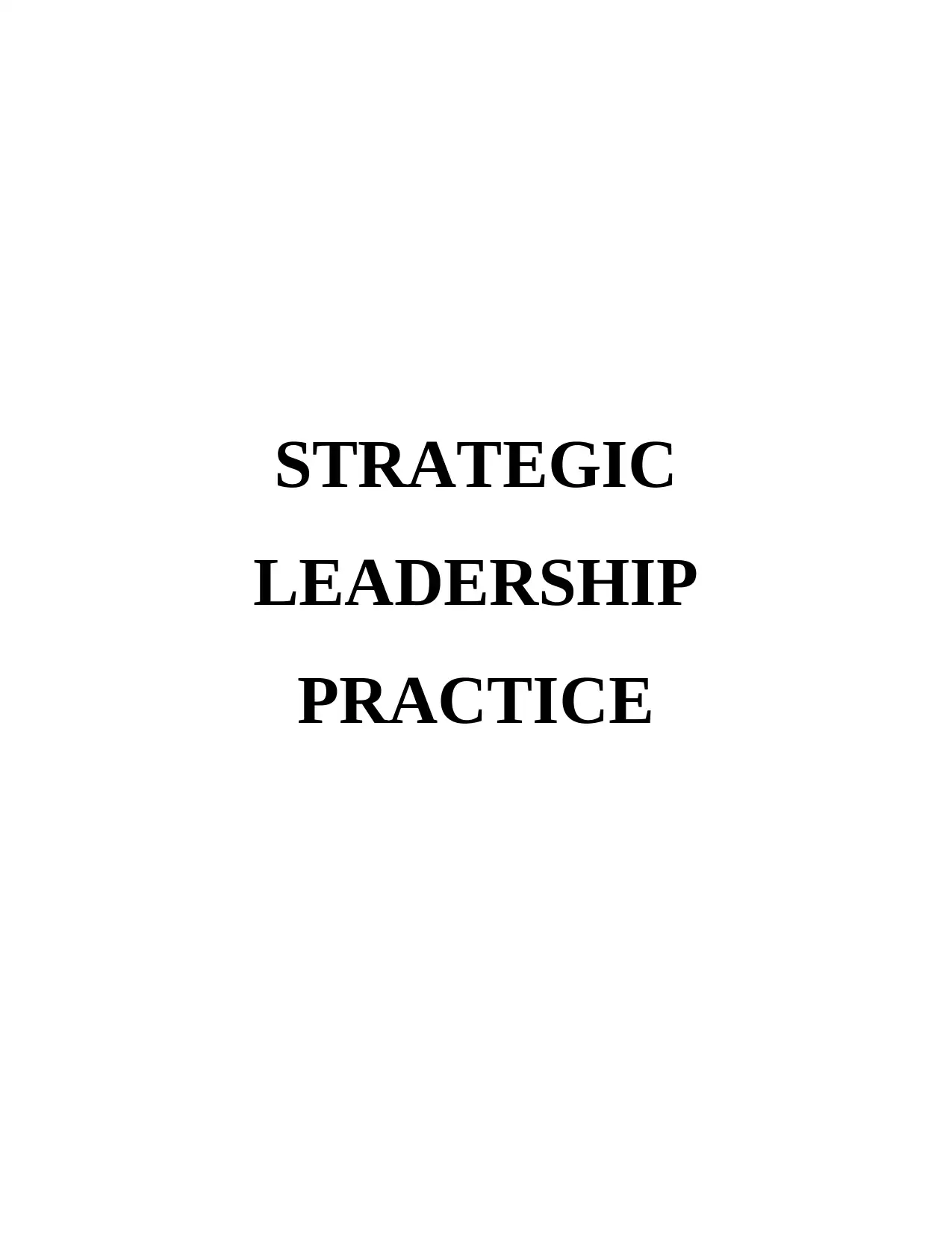
STRATEGIC
LEADERSHIP
PRACTICE
LEADERSHIP
PRACTICE
Paraphrase This Document
Need a fresh take? Get an instant paraphrase of this document with our AI Paraphraser
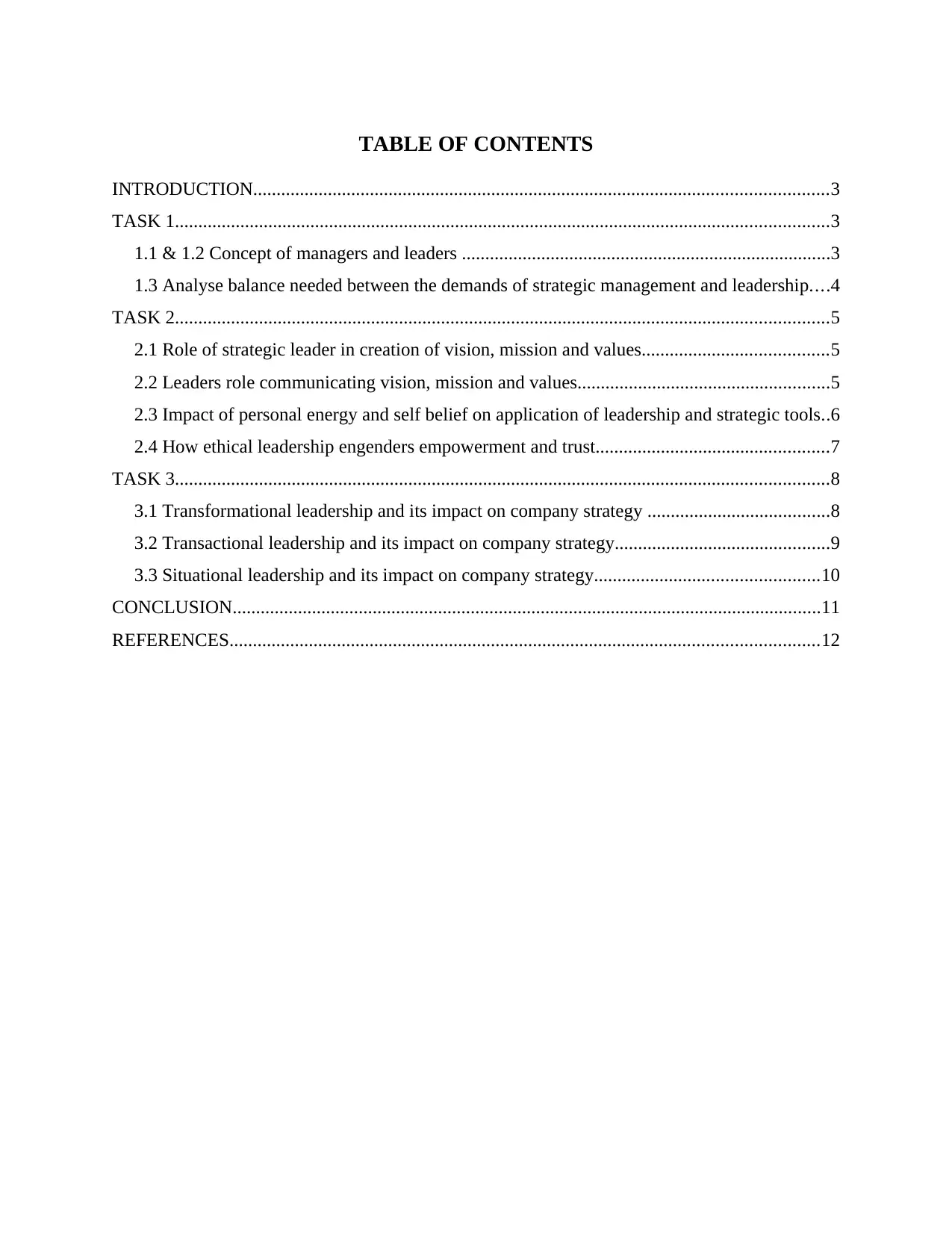
TABLE OF CONTENTS
INTRODUCTION...........................................................................................................................3
TASK 1............................................................................................................................................3
1.1 & 1.2 Concept of managers and leaders ...............................................................................3
1.3 Analyse balance needed between the demands of strategic management and leadership....4
TASK 2............................................................................................................................................5
2.1 Role of strategic leader in creation of vision, mission and values........................................5
2.2 Leaders role communicating vision, mission and values......................................................5
2.3 Impact of personal energy and self belief on application of leadership and strategic tools..6
2.4 How ethical leadership engenders empowerment and trust..................................................7
TASK 3............................................................................................................................................8
3.1 Transformational leadership and its impact on company strategy .......................................8
3.2 Transactional leadership and its impact on company strategy..............................................9
3.3 Situational leadership and its impact on company strategy................................................10
CONCLUSION..............................................................................................................................11
REFERENCES..............................................................................................................................12
INTRODUCTION...........................................................................................................................3
TASK 1............................................................................................................................................3
1.1 & 1.2 Concept of managers and leaders ...............................................................................3
1.3 Analyse balance needed between the demands of strategic management and leadership....4
TASK 2............................................................................................................................................5
2.1 Role of strategic leader in creation of vision, mission and values........................................5
2.2 Leaders role communicating vision, mission and values......................................................5
2.3 Impact of personal energy and self belief on application of leadership and strategic tools..6
2.4 How ethical leadership engenders empowerment and trust..................................................7
TASK 3............................................................................................................................................8
3.1 Transformational leadership and its impact on company strategy .......................................8
3.2 Transactional leadership and its impact on company strategy..............................................9
3.3 Situational leadership and its impact on company strategy................................................10
CONCLUSION..............................................................................................................................11
REFERENCES..............................................................................................................................12
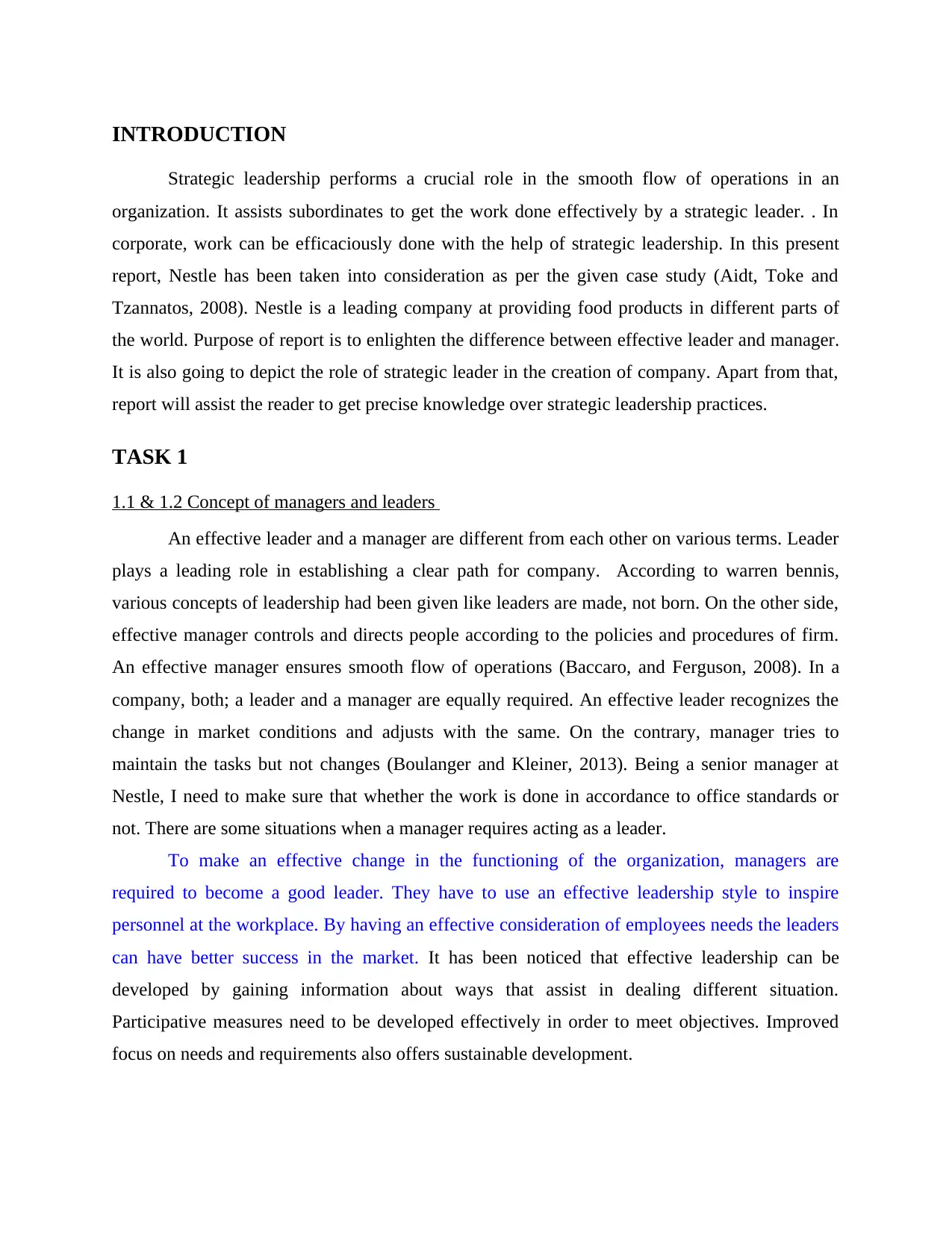
INTRODUCTION
Strategic leadership performs a crucial role in the smooth flow of operations in an
organization. It assists subordinates to get the work done effectively by a strategic leader. . In
corporate, work can be efficaciously done with the help of strategic leadership. In this present
report, Nestle has been taken into consideration as per the given case study (Aidt, Toke and
Tzannatos, 2008). Nestle is a leading company at providing food products in different parts of
the world. Purpose of report is to enlighten the difference between effective leader and manager.
It is also going to depict the role of strategic leader in the creation of company. Apart from that,
report will assist the reader to get precise knowledge over strategic leadership practices.
TASK 1
1.1 & 1.2 Concept of managers and leaders
An effective leader and a manager are different from each other on various terms. Leader
plays a leading role in establishing a clear path for company. According to warren bennis,
various concepts of leadership had been given like leaders are made, not born. On the other side,
effective manager controls and directs people according to the policies and procedures of firm.
An effective manager ensures smooth flow of operations (Baccaro, and Ferguson, 2008). In a
company, both; a leader and a manager are equally required. An effective leader recognizes the
change in market conditions and adjusts with the same. On the contrary, manager tries to
maintain the tasks but not changes (Boulanger and Kleiner, 2013). Being a senior manager at
Nestle, I need to make sure that whether the work is done in accordance to office standards or
not. There are some situations when a manager requires acting as a leader.
To make an effective change in the functioning of the organization, managers are
required to become a good leader. They have to use an effective leadership style to inspire
personnel at the workplace. By having an effective consideration of employees needs the leaders
can have better success in the market. It has been noticed that effective leadership can be
developed by gaining information about ways that assist in dealing different situation.
Participative measures need to be developed effectively in order to meet objectives. Improved
focus on needs and requirements also offers sustainable development.
Strategic leadership performs a crucial role in the smooth flow of operations in an
organization. It assists subordinates to get the work done effectively by a strategic leader. . In
corporate, work can be efficaciously done with the help of strategic leadership. In this present
report, Nestle has been taken into consideration as per the given case study (Aidt, Toke and
Tzannatos, 2008). Nestle is a leading company at providing food products in different parts of
the world. Purpose of report is to enlighten the difference between effective leader and manager.
It is also going to depict the role of strategic leader in the creation of company. Apart from that,
report will assist the reader to get precise knowledge over strategic leadership practices.
TASK 1
1.1 & 1.2 Concept of managers and leaders
An effective leader and a manager are different from each other on various terms. Leader
plays a leading role in establishing a clear path for company. According to warren bennis,
various concepts of leadership had been given like leaders are made, not born. On the other side,
effective manager controls and directs people according to the policies and procedures of firm.
An effective manager ensures smooth flow of operations (Baccaro, and Ferguson, 2008). In a
company, both; a leader and a manager are equally required. An effective leader recognizes the
change in market conditions and adjusts with the same. On the contrary, manager tries to
maintain the tasks but not changes (Boulanger and Kleiner, 2013). Being a senior manager at
Nestle, I need to make sure that whether the work is done in accordance to office standards or
not. There are some situations when a manager requires acting as a leader.
To make an effective change in the functioning of the organization, managers are
required to become a good leader. They have to use an effective leadership style to inspire
personnel at the workplace. By having an effective consideration of employees needs the leaders
can have better success in the market. It has been noticed that effective leadership can be
developed by gaining information about ways that assist in dealing different situation.
Participative measures need to be developed effectively in order to meet objectives. Improved
focus on needs and requirements also offers sustainable development.
⊘ This is a preview!⊘
Do you want full access?
Subscribe today to unlock all pages.

Trusted by 1+ million students worldwide
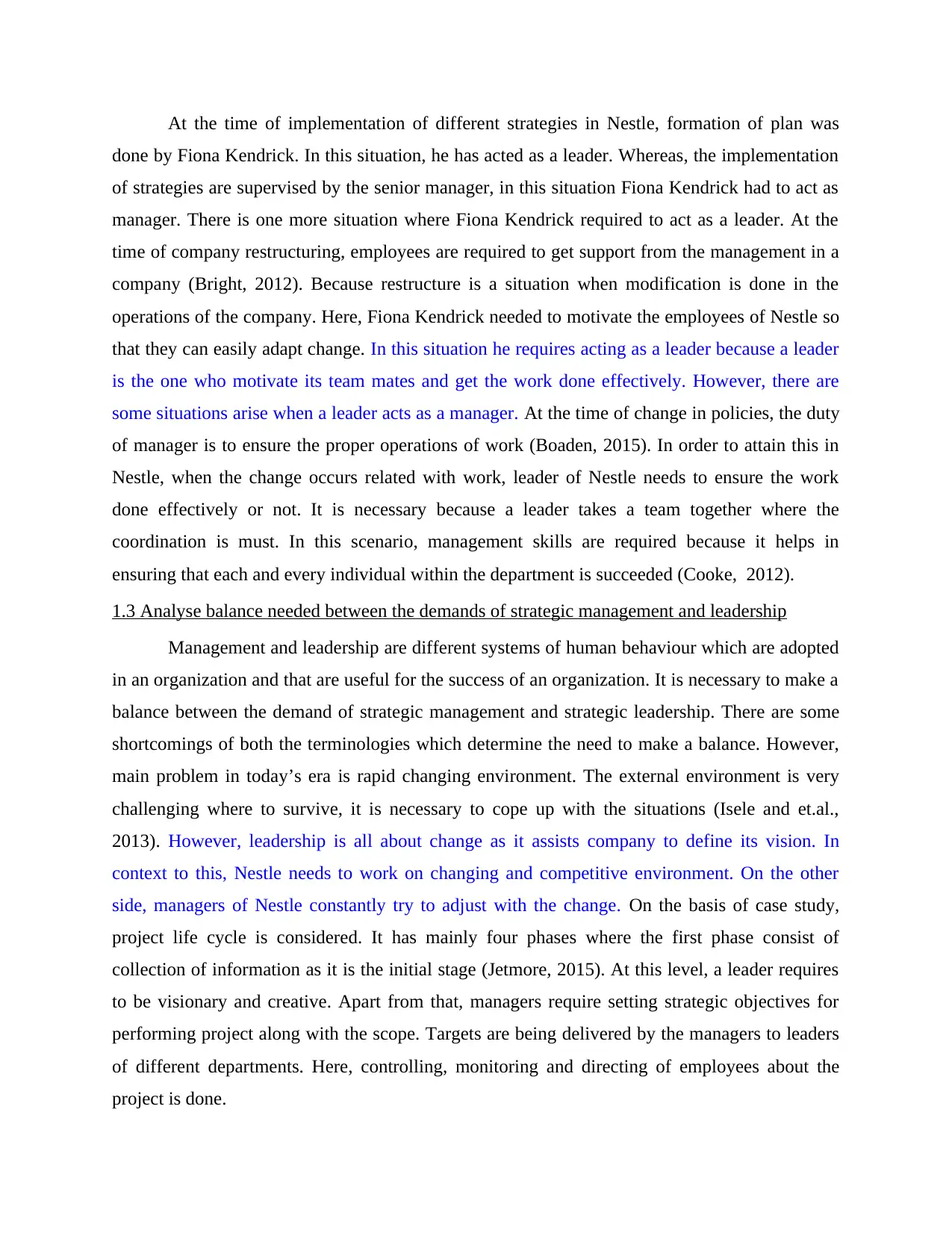
At the time of implementation of different strategies in Nestle, formation of plan was
done by Fiona Kendrick. In this situation, he has acted as a leader. Whereas, the implementation
of strategies are supervised by the senior manager, in this situation Fiona Kendrick had to act as
manager. There is one more situation where Fiona Kendrick required to act as a leader. At the
time of company restructuring, employees are required to get support from the management in a
company (Bright, 2012). Because restructure is a situation when modification is done in the
operations of the company. Here, Fiona Kendrick needed to motivate the employees of Nestle so
that they can easily adapt change. In this situation he requires acting as a leader because a leader
is the one who motivate its team mates and get the work done effectively. However, there are
some situations arise when a leader acts as a manager. At the time of change in policies, the duty
of manager is to ensure the proper operations of work (Boaden, 2015). In order to attain this in
Nestle, when the change occurs related with work, leader of Nestle needs to ensure the work
done effectively or not. It is necessary because a leader takes a team together where the
coordination is must. In this scenario, management skills are required because it helps in
ensuring that each and every individual within the department is succeeded (Cooke, 2012).
1.3 Analyse balance needed between the demands of strategic management and leadership
Management and leadership are different systems of human behaviour which are adopted
in an organization and that are useful for the success of an organization. It is necessary to make a
balance between the demand of strategic management and strategic leadership. There are some
shortcomings of both the terminologies which determine the need to make a balance. However,
main problem in today’s era is rapid changing environment. The external environment is very
challenging where to survive, it is necessary to cope up with the situations (Isele and et.al.,
2013). However, leadership is all about change as it assists company to define its vision. In
context to this, Nestle needs to work on changing and competitive environment. On the other
side, managers of Nestle constantly try to adjust with the change. On the basis of case study,
project life cycle is considered. It has mainly four phases where the first phase consist of
collection of information as it is the initial stage (Jetmore, 2015). At this level, a leader requires
to be visionary and creative. Apart from that, managers require setting strategic objectives for
performing project along with the scope. Targets are being delivered by the managers to leaders
of different departments. Here, controlling, monitoring and directing of employees about the
project is done.
done by Fiona Kendrick. In this situation, he has acted as a leader. Whereas, the implementation
of strategies are supervised by the senior manager, in this situation Fiona Kendrick had to act as
manager. There is one more situation where Fiona Kendrick required to act as a leader. At the
time of company restructuring, employees are required to get support from the management in a
company (Bright, 2012). Because restructure is a situation when modification is done in the
operations of the company. Here, Fiona Kendrick needed to motivate the employees of Nestle so
that they can easily adapt change. In this situation he requires acting as a leader because a leader
is the one who motivate its team mates and get the work done effectively. However, there are
some situations arise when a leader acts as a manager. At the time of change in policies, the duty
of manager is to ensure the proper operations of work (Boaden, 2015). In order to attain this in
Nestle, when the change occurs related with work, leader of Nestle needs to ensure the work
done effectively or not. It is necessary because a leader takes a team together where the
coordination is must. In this scenario, management skills are required because it helps in
ensuring that each and every individual within the department is succeeded (Cooke, 2012).
1.3 Analyse balance needed between the demands of strategic management and leadership
Management and leadership are different systems of human behaviour which are adopted
in an organization and that are useful for the success of an organization. It is necessary to make a
balance between the demand of strategic management and strategic leadership. There are some
shortcomings of both the terminologies which determine the need to make a balance. However,
main problem in today’s era is rapid changing environment. The external environment is very
challenging where to survive, it is necessary to cope up with the situations (Isele and et.al.,
2013). However, leadership is all about change as it assists company to define its vision. In
context to this, Nestle needs to work on changing and competitive environment. On the other
side, managers of Nestle constantly try to adjust with the change. On the basis of case study,
project life cycle is considered. It has mainly four phases where the first phase consist of
collection of information as it is the initial stage (Jetmore, 2015). At this level, a leader requires
to be visionary and creative. Apart from that, managers require setting strategic objectives for
performing project along with the scope. Targets are being delivered by the managers to leaders
of different departments. Here, controlling, monitoring and directing of employees about the
project is done.
Paraphrase This Document
Need a fresh take? Get an instant paraphrase of this document with our AI Paraphraser
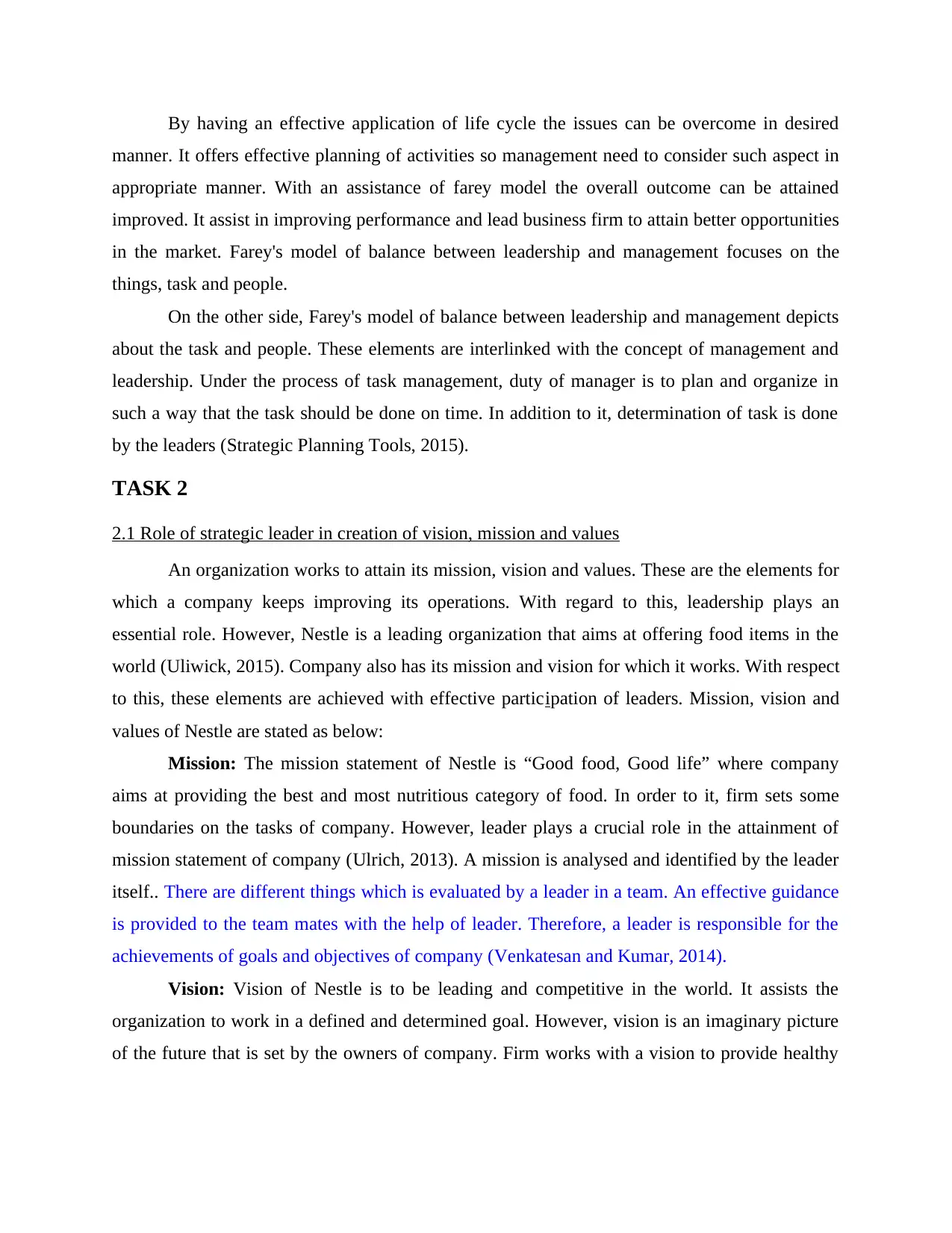
By having an effective application of life cycle the issues can be overcome in desired
manner. It offers effective planning of activities so management need to consider such aspect in
appropriate manner. With an assistance of farey model the overall outcome can be attained
improved. It assist in improving performance and lead business firm to attain better opportunities
in the market. Farey's model of balance between leadership and management focuses on the
things, task and people.
On the other side, Farey's model of balance between leadership and management depicts
about the task and people. These elements are interlinked with the concept of management and
leadership. Under the process of task management, duty of manager is to plan and organize in
such a way that the task should be done on time. In addition to it, determination of task is done
by the leaders (Strategic Planning Tools, 2015).
TASK 2
2.1 Role of strategic leader in creation of vision, mission and values
An organization works to attain its mission, vision and values. These are the elements for
which a company keeps improving its operations. With regard to this, leadership plays an
essential role. However, Nestle is a leading organization that aims at offering food items in the
world (Uliwick, 2015). Company also has its mission and vision for which it works. With respect
to this, these elements are achieved with effective participation of leaders. Mission, vision and
values of Nestle are stated as below:
Mission: The mission statement of Nestle is “Good food, Good life” where company
aims at providing the best and most nutritious category of food. In order to it, firm sets some
boundaries on the tasks of company. However, leader plays a crucial role in the attainment of
mission statement of company (Ulrich, 2013). A mission is analysed and identified by the leader
itself.. There are different things which is evaluated by a leader in a team. An effective guidance
is provided to the team mates with the help of leader. Therefore, a leader is responsible for the
achievements of goals and objectives of company (Venkatesan and Kumar, 2014).
Vision: Vision of Nestle is to be leading and competitive in the world. It assists the
organization to work in a defined and determined goal. However, vision is an imaginary picture
of the future that is set by the owners of company. Firm works with a vision to provide healthy
manner. It offers effective planning of activities so management need to consider such aspect in
appropriate manner. With an assistance of farey model the overall outcome can be attained
improved. It assist in improving performance and lead business firm to attain better opportunities
in the market. Farey's model of balance between leadership and management focuses on the
things, task and people.
On the other side, Farey's model of balance between leadership and management depicts
about the task and people. These elements are interlinked with the concept of management and
leadership. Under the process of task management, duty of manager is to plan and organize in
such a way that the task should be done on time. In addition to it, determination of task is done
by the leaders (Strategic Planning Tools, 2015).
TASK 2
2.1 Role of strategic leader in creation of vision, mission and values
An organization works to attain its mission, vision and values. These are the elements for
which a company keeps improving its operations. With regard to this, leadership plays an
essential role. However, Nestle is a leading organization that aims at offering food items in the
world (Uliwick, 2015). Company also has its mission and vision for which it works. With respect
to this, these elements are achieved with effective participation of leaders. Mission, vision and
values of Nestle are stated as below:
Mission: The mission statement of Nestle is “Good food, Good life” where company
aims at providing the best and most nutritious category of food. In order to it, firm sets some
boundaries on the tasks of company. However, leader plays a crucial role in the attainment of
mission statement of company (Ulrich, 2013). A mission is analysed and identified by the leader
itself.. There are different things which is evaluated by a leader in a team. An effective guidance
is provided to the team mates with the help of leader. Therefore, a leader is responsible for the
achievements of goals and objectives of company (Venkatesan and Kumar, 2014).
Vision: Vision of Nestle is to be leading and competitive in the world. It assists the
organization to work in a defined and determined goal. However, vision is an imaginary picture
of the future that is set by the owners of company. Firm works with a vision to provide healthy
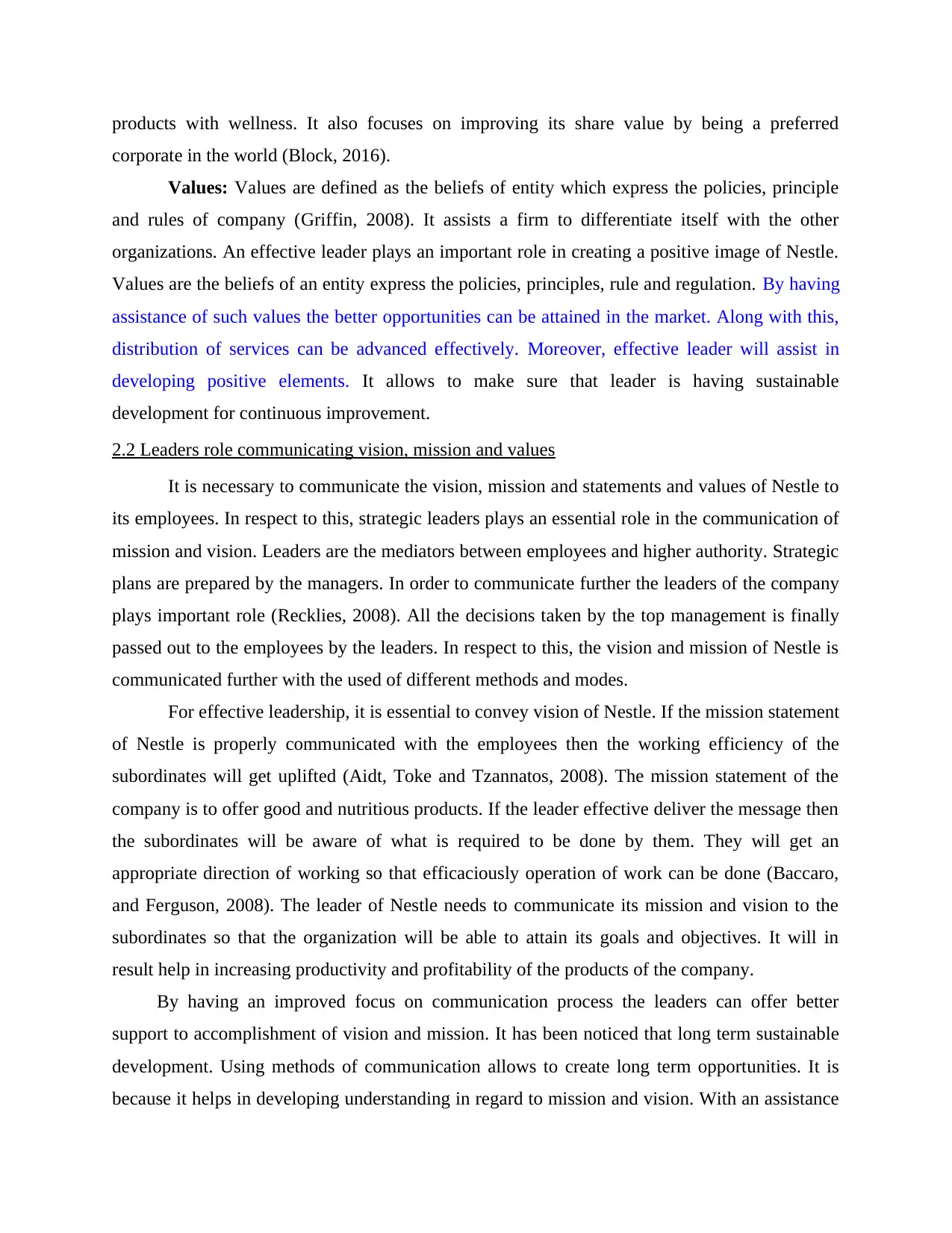
products with wellness. It also focuses on improving its share value by being a preferred
corporate in the world (Block, 2016).
Values: Values are defined as the beliefs of entity which express the policies, principle
and rules of company (Griffin, 2008). It assists a firm to differentiate itself with the other
organizations. An effective leader plays an important role in creating a positive image of Nestle.
Values are the beliefs of an entity express the policies, principles, rule and regulation. By having
assistance of such values the better opportunities can be attained in the market. Along with this,
distribution of services can be advanced effectively. Moreover, effective leader will assist in
developing positive elements. It allows to make sure that leader is having sustainable
development for continuous improvement.
2.2 Leaders role communicating vision, mission and values
It is necessary to communicate the vision, mission and statements and values of Nestle to
its employees. In respect to this, strategic leaders plays an essential role in the communication of
mission and vision. Leaders are the mediators between employees and higher authority. Strategic
plans are prepared by the managers. In order to communicate further the leaders of the company
plays important role (Recklies, 2008). All the decisions taken by the top management is finally
passed out to the employees by the leaders. In respect to this, the vision and mission of Nestle is
communicated further with the used of different methods and modes.
For effective leadership, it is essential to convey vision of Nestle. If the mission statement
of Nestle is properly communicated with the employees then the working efficiency of the
subordinates will get uplifted (Aidt, Toke and Tzannatos, 2008). The mission statement of the
company is to offer good and nutritious products. If the leader effective deliver the message then
the subordinates will be aware of what is required to be done by them. They will get an
appropriate direction of working so that efficaciously operation of work can be done (Baccaro,
and Ferguson, 2008). The leader of Nestle needs to communicate its mission and vision to the
subordinates so that the organization will be able to attain its goals and objectives. It will in
result help in increasing productivity and profitability of the products of the company.
By having an improved focus on communication process the leaders can offer better
support to accomplishment of vision and mission. It has been noticed that long term sustainable
development. Using methods of communication allows to create long term opportunities. It is
because it helps in developing understanding in regard to mission and vision. With an assistance
corporate in the world (Block, 2016).
Values: Values are defined as the beliefs of entity which express the policies, principle
and rules of company (Griffin, 2008). It assists a firm to differentiate itself with the other
organizations. An effective leader plays an important role in creating a positive image of Nestle.
Values are the beliefs of an entity express the policies, principles, rule and regulation. By having
assistance of such values the better opportunities can be attained in the market. Along with this,
distribution of services can be advanced effectively. Moreover, effective leader will assist in
developing positive elements. It allows to make sure that leader is having sustainable
development for continuous improvement.
2.2 Leaders role communicating vision, mission and values
It is necessary to communicate the vision, mission and statements and values of Nestle to
its employees. In respect to this, strategic leaders plays an essential role in the communication of
mission and vision. Leaders are the mediators between employees and higher authority. Strategic
plans are prepared by the managers. In order to communicate further the leaders of the company
plays important role (Recklies, 2008). All the decisions taken by the top management is finally
passed out to the employees by the leaders. In respect to this, the vision and mission of Nestle is
communicated further with the used of different methods and modes.
For effective leadership, it is essential to convey vision of Nestle. If the mission statement
of Nestle is properly communicated with the employees then the working efficiency of the
subordinates will get uplifted (Aidt, Toke and Tzannatos, 2008). The mission statement of the
company is to offer good and nutritious products. If the leader effective deliver the message then
the subordinates will be aware of what is required to be done by them. They will get an
appropriate direction of working so that efficaciously operation of work can be done (Baccaro,
and Ferguson, 2008). The leader of Nestle needs to communicate its mission and vision to the
subordinates so that the organization will be able to attain its goals and objectives. It will in
result help in increasing productivity and profitability of the products of the company.
By having an improved focus on communication process the leaders can offer better
support to accomplishment of vision and mission. It has been noticed that long term sustainable
development. Using methods of communication allows to create long term opportunities. It is
because it helps in developing understanding in regard to mission and vision. With an assistance
⊘ This is a preview!⊘
Do you want full access?
Subscribe today to unlock all pages.

Trusted by 1+ million students worldwide
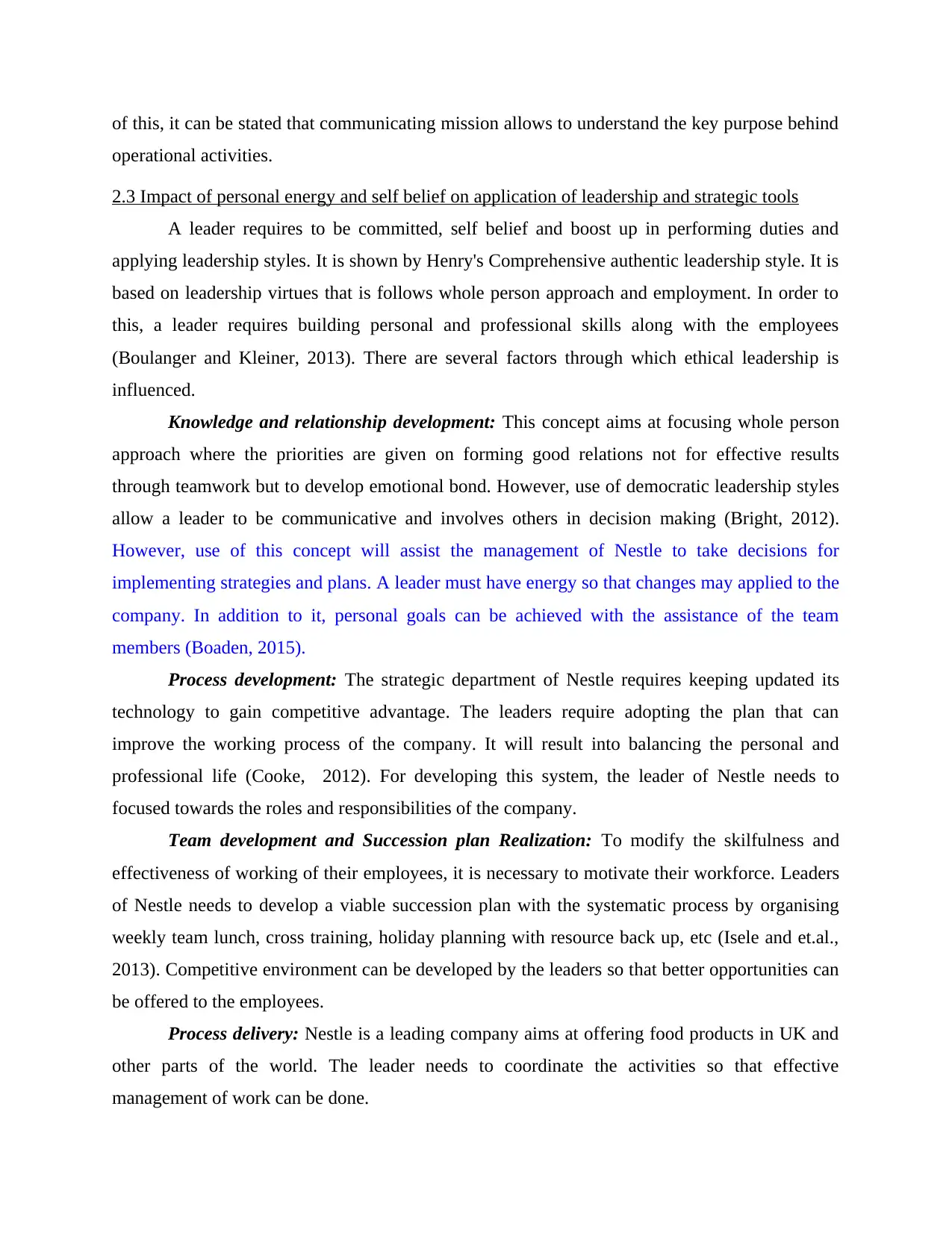
of this, it can be stated that communicating mission allows to understand the key purpose behind
operational activities.
2.3 Impact of personal energy and self belief on application of leadership and strategic tools
A leader requires to be committed, self belief and boost up in performing duties and
applying leadership styles. It is shown by Henry's Comprehensive authentic leadership style. It is
based on leadership virtues that is follows whole person approach and employment. In order to
this, a leader requires building personal and professional skills along with the employees
(Boulanger and Kleiner, 2013). There are several factors through which ethical leadership is
influenced.
Knowledge and relationship development: This concept aims at focusing whole person
approach where the priorities are given on forming good relations not for effective results
through teamwork but to develop emotional bond. However, use of democratic leadership styles
allow a leader to be communicative and involves others in decision making (Bright, 2012).
However, use of this concept will assist the management of Nestle to take decisions for
implementing strategies and plans. A leader must have energy so that changes may applied to the
company. In addition to it, personal goals can be achieved with the assistance of the team
members (Boaden, 2015).
Process development: The strategic department of Nestle requires keeping updated its
technology to gain competitive advantage. The leaders require adopting the plan that can
improve the working process of the company. It will result into balancing the personal and
professional life (Cooke, 2012). For developing this system, the leader of Nestle needs to
focused towards the roles and responsibilities of the company.
Team development and Succession plan Realization: To modify the skilfulness and
effectiveness of working of their employees, it is necessary to motivate their workforce. Leaders
of Nestle needs to develop a viable succession plan with the systematic process by organising
weekly team lunch, cross training, holiday planning with resource back up, etc (Isele and et.al.,
2013). Competitive environment can be developed by the leaders so that better opportunities can
be offered to the employees.
Process delivery: Nestle is a leading company aims at offering food products in UK and
other parts of the world. The leader needs to coordinate the activities so that effective
management of work can be done.
operational activities.
2.3 Impact of personal energy and self belief on application of leadership and strategic tools
A leader requires to be committed, self belief and boost up in performing duties and
applying leadership styles. It is shown by Henry's Comprehensive authentic leadership style. It is
based on leadership virtues that is follows whole person approach and employment. In order to
this, a leader requires building personal and professional skills along with the employees
(Boulanger and Kleiner, 2013). There are several factors through which ethical leadership is
influenced.
Knowledge and relationship development: This concept aims at focusing whole person
approach where the priorities are given on forming good relations not for effective results
through teamwork but to develop emotional bond. However, use of democratic leadership styles
allow a leader to be communicative and involves others in decision making (Bright, 2012).
However, use of this concept will assist the management of Nestle to take decisions for
implementing strategies and plans. A leader must have energy so that changes may applied to the
company. In addition to it, personal goals can be achieved with the assistance of the team
members (Boaden, 2015).
Process development: The strategic department of Nestle requires keeping updated its
technology to gain competitive advantage. The leaders require adopting the plan that can
improve the working process of the company. It will result into balancing the personal and
professional life (Cooke, 2012). For developing this system, the leader of Nestle needs to
focused towards the roles and responsibilities of the company.
Team development and Succession plan Realization: To modify the skilfulness and
effectiveness of working of their employees, it is necessary to motivate their workforce. Leaders
of Nestle needs to develop a viable succession plan with the systematic process by organising
weekly team lunch, cross training, holiday planning with resource back up, etc (Isele and et.al.,
2013). Competitive environment can be developed by the leaders so that better opportunities can
be offered to the employees.
Process delivery: Nestle is a leading company aims at offering food products in UK and
other parts of the world. The leader needs to coordinate the activities so that effective
management of work can be done.
Paraphrase This Document
Need a fresh take? Get an instant paraphrase of this document with our AI Paraphraser
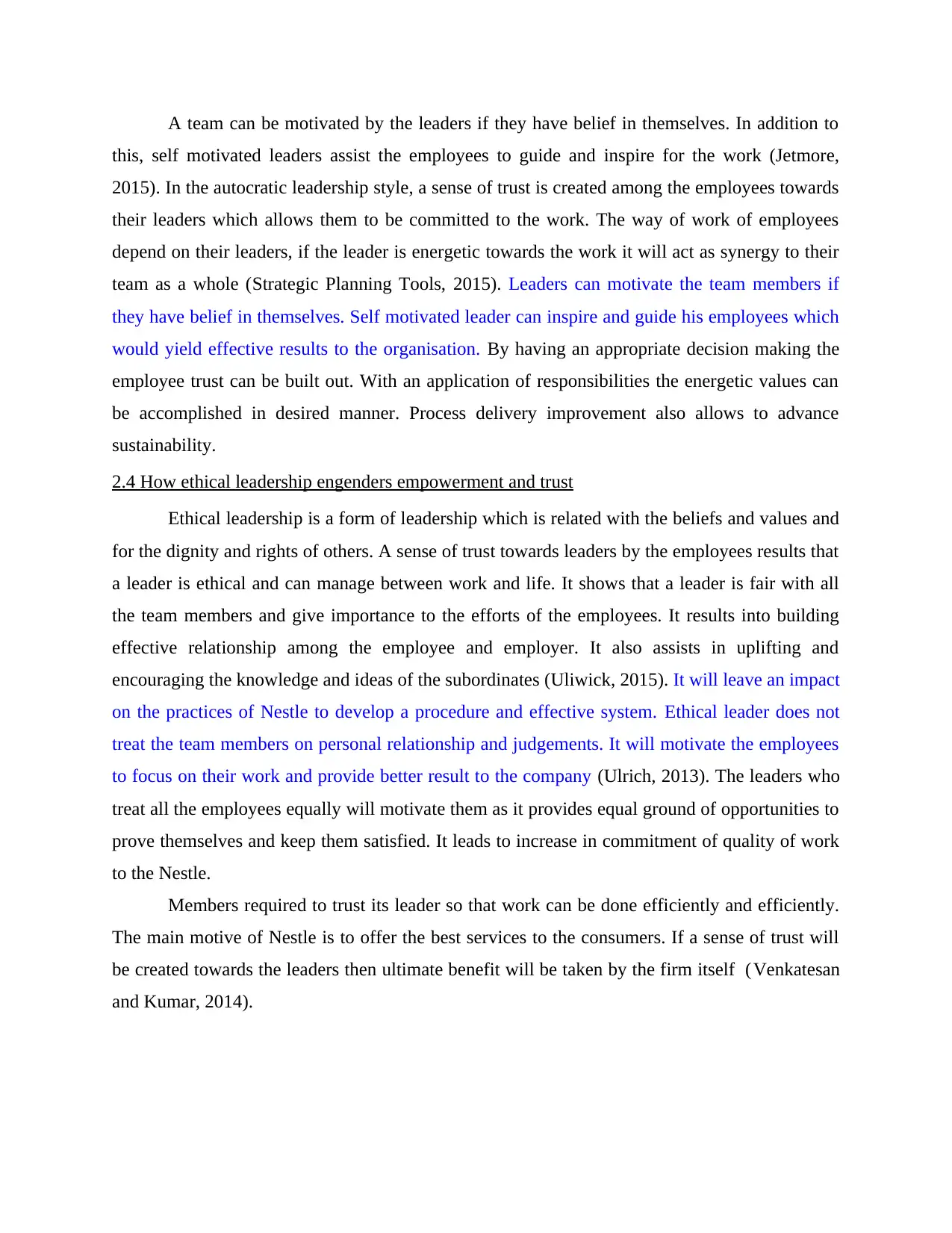
A team can be motivated by the leaders if they have belief in themselves. In addition to
this, self motivated leaders assist the employees to guide and inspire for the work (Jetmore,
2015). In the autocratic leadership style, a sense of trust is created among the employees towards
their leaders which allows them to be committed to the work. The way of work of employees
depend on their leaders, if the leader is energetic towards the work it will act as synergy to their
team as a whole (Strategic Planning Tools, 2015). Leaders can motivate the team members if
they have belief in themselves. Self motivated leader can inspire and guide his employees which
would yield effective results to the organisation. By having an appropriate decision making the
employee trust can be built out. With an application of responsibilities the energetic values can
be accomplished in desired manner. Process delivery improvement also allows to advance
sustainability.
2.4 How ethical leadership engenders empowerment and trust
Ethical leadership is a form of leadership which is related with the beliefs and values and
for the dignity and rights of others. A sense of trust towards leaders by the employees results that
a leader is ethical and can manage between work and life. It shows that a leader is fair with all
the team members and give importance to the efforts of the employees. It results into building
effective relationship among the employee and employer. It also assists in uplifting and
encouraging the knowledge and ideas of the subordinates (Uliwick, 2015). It will leave an impact
on the practices of Nestle to develop a procedure and effective system. Ethical leader does not
treat the team members on personal relationship and judgements. It will motivate the employees
to focus on their work and provide better result to the company (Ulrich, 2013). The leaders who
treat all the employees equally will motivate them as it provides equal ground of opportunities to
prove themselves and keep them satisfied. It leads to increase in commitment of quality of work
to the Nestle.
Members required to trust its leader so that work can be done efficiently and efficiently.
The main motive of Nestle is to offer the best services to the consumers. If a sense of trust will
be created towards the leaders then ultimate benefit will be taken by the firm itself (Venkatesan
and Kumar, 2014).
this, self motivated leaders assist the employees to guide and inspire for the work (Jetmore,
2015). In the autocratic leadership style, a sense of trust is created among the employees towards
their leaders which allows them to be committed to the work. The way of work of employees
depend on their leaders, if the leader is energetic towards the work it will act as synergy to their
team as a whole (Strategic Planning Tools, 2015). Leaders can motivate the team members if
they have belief in themselves. Self motivated leader can inspire and guide his employees which
would yield effective results to the organisation. By having an appropriate decision making the
employee trust can be built out. With an application of responsibilities the energetic values can
be accomplished in desired manner. Process delivery improvement also allows to advance
sustainability.
2.4 How ethical leadership engenders empowerment and trust
Ethical leadership is a form of leadership which is related with the beliefs and values and
for the dignity and rights of others. A sense of trust towards leaders by the employees results that
a leader is ethical and can manage between work and life. It shows that a leader is fair with all
the team members and give importance to the efforts of the employees. It results into building
effective relationship among the employee and employer. It also assists in uplifting and
encouraging the knowledge and ideas of the subordinates (Uliwick, 2015). It will leave an impact
on the practices of Nestle to develop a procedure and effective system. Ethical leader does not
treat the team members on personal relationship and judgements. It will motivate the employees
to focus on their work and provide better result to the company (Ulrich, 2013). The leaders who
treat all the employees equally will motivate them as it provides equal ground of opportunities to
prove themselves and keep them satisfied. It leads to increase in commitment of quality of work
to the Nestle.
Members required to trust its leader so that work can be done efficiently and efficiently.
The main motive of Nestle is to offer the best services to the consumers. If a sense of trust will
be created towards the leaders then ultimate benefit will be taken by the firm itself (Venkatesan
and Kumar, 2014).
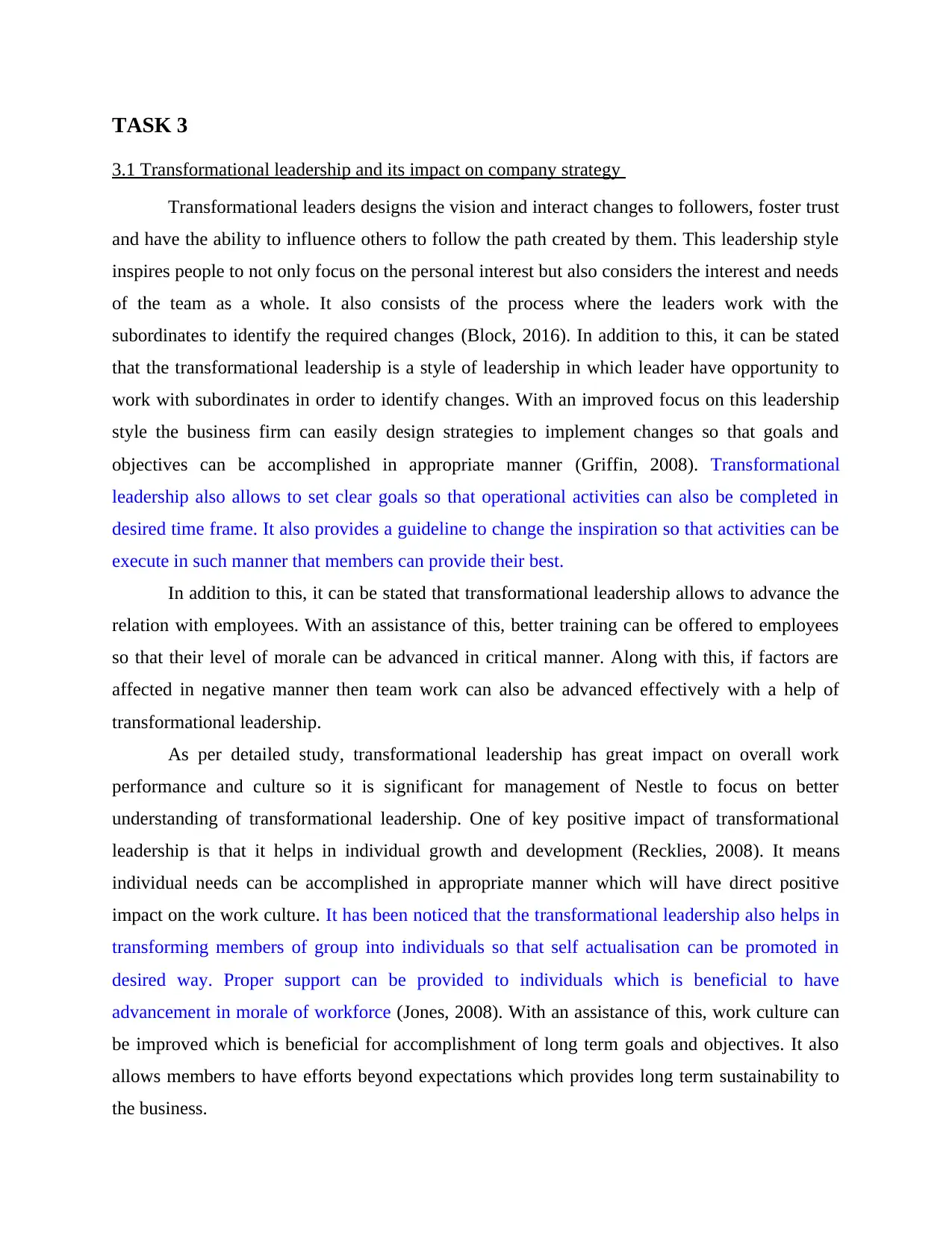
TASK 3
3.1 Transformational leadership and its impact on company strategy
Transformational leaders designs the vision and interact changes to followers, foster trust
and have the ability to influence others to follow the path created by them. This leadership style
inspires people to not only focus on the personal interest but also considers the interest and needs
of the team as a whole. It also consists of the process where the leaders work with the
subordinates to identify the required changes (Block, 2016). In addition to this, it can be stated
that the transformational leadership is a style of leadership in which leader have opportunity to
work with subordinates in order to identify changes. With an improved focus on this leadership
style the business firm can easily design strategies to implement changes so that goals and
objectives can be accomplished in appropriate manner (Griffin, 2008). Transformational
leadership also allows to set clear goals so that operational activities can also be completed in
desired time frame. It also provides a guideline to change the inspiration so that activities can be
execute in such manner that members can provide their best.
In addition to this, it can be stated that transformational leadership allows to advance the
relation with employees. With an assistance of this, better training can be offered to employees
so that their level of morale can be advanced in critical manner. Along with this, if factors are
affected in negative manner then team work can also be advanced effectively with a help of
transformational leadership.
As per detailed study, transformational leadership has great impact on overall work
performance and culture so it is significant for management of Nestle to focus on better
understanding of transformational leadership. One of key positive impact of transformational
leadership is that it helps in individual growth and development (Recklies, 2008). It means
individual needs can be accomplished in appropriate manner which will have direct positive
impact on the work culture. It has been noticed that the transformational leadership also helps in
transforming members of group into individuals so that self actualisation can be promoted in
desired way. Proper support can be provided to individuals which is beneficial to have
advancement in morale of workforce (Jones, 2008). With an assistance of this, work culture can
be improved which is beneficial for accomplishment of long term goals and objectives. It also
allows members to have efforts beyond expectations which provides long term sustainability to
the business.
3.1 Transformational leadership and its impact on company strategy
Transformational leaders designs the vision and interact changes to followers, foster trust
and have the ability to influence others to follow the path created by them. This leadership style
inspires people to not only focus on the personal interest but also considers the interest and needs
of the team as a whole. It also consists of the process where the leaders work with the
subordinates to identify the required changes (Block, 2016). In addition to this, it can be stated
that the transformational leadership is a style of leadership in which leader have opportunity to
work with subordinates in order to identify changes. With an improved focus on this leadership
style the business firm can easily design strategies to implement changes so that goals and
objectives can be accomplished in appropriate manner (Griffin, 2008). Transformational
leadership also allows to set clear goals so that operational activities can also be completed in
desired time frame. It also provides a guideline to change the inspiration so that activities can be
execute in such manner that members can provide their best.
In addition to this, it can be stated that transformational leadership allows to advance the
relation with employees. With an assistance of this, better training can be offered to employees
so that their level of morale can be advanced in critical manner. Along with this, if factors are
affected in negative manner then team work can also be advanced effectively with a help of
transformational leadership.
As per detailed study, transformational leadership has great impact on overall work
performance and culture so it is significant for management of Nestle to focus on better
understanding of transformational leadership. One of key positive impact of transformational
leadership is that it helps in individual growth and development (Recklies, 2008). It means
individual needs can be accomplished in appropriate manner which will have direct positive
impact on the work culture. It has been noticed that the transformational leadership also helps in
transforming members of group into individuals so that self actualisation can be promoted in
desired way. Proper support can be provided to individuals which is beneficial to have
advancement in morale of workforce (Jones, 2008). With an assistance of this, work culture can
be improved which is beneficial for accomplishment of long term goals and objectives. It also
allows members to have efforts beyond expectations which provides long term sustainability to
the business.
⊘ This is a preview!⊘
Do you want full access?
Subscribe today to unlock all pages.

Trusted by 1+ million students worldwide
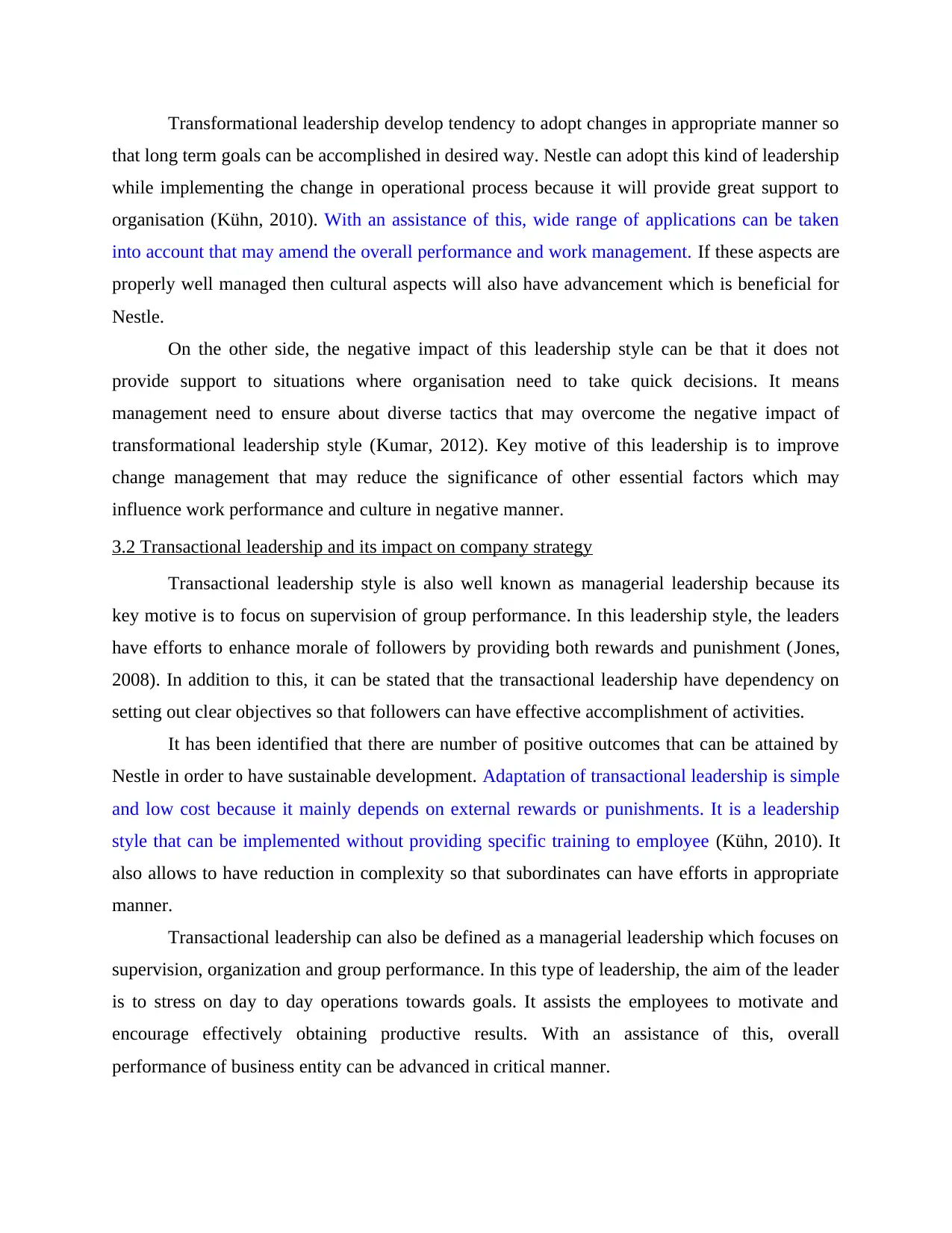
Transformational leadership develop tendency to adopt changes in appropriate manner so
that long term goals can be accomplished in desired way. Nestle can adopt this kind of leadership
while implementing the change in operational process because it will provide great support to
organisation (Kühn, 2010). With an assistance of this, wide range of applications can be taken
into account that may amend the overall performance and work management. If these aspects are
properly well managed then cultural aspects will also have advancement which is beneficial for
Nestle.
On the other side, the negative impact of this leadership style can be that it does not
provide support to situations where organisation need to take quick decisions. It means
management need to ensure about diverse tactics that may overcome the negative impact of
transformational leadership style (Kumar, 2012). Key motive of this leadership is to improve
change management that may reduce the significance of other essential factors which may
influence work performance and culture in negative manner.
3.2 Transactional leadership and its impact on company strategy
Transactional leadership style is also well known as managerial leadership because its
key motive is to focus on supervision of group performance. In this leadership style, the leaders
have efforts to enhance morale of followers by providing both rewards and punishment (Jones,
2008). In addition to this, it can be stated that the transactional leadership have dependency on
setting out clear objectives so that followers can have effective accomplishment of activities.
It has been identified that there are number of positive outcomes that can be attained by
Nestle in order to have sustainable development. Adaptation of transactional leadership is simple
and low cost because it mainly depends on external rewards or punishments. It is a leadership
style that can be implemented without providing specific training to employee (Kühn, 2010). It
also allows to have reduction in complexity so that subordinates can have efforts in appropriate
manner.
Transactional leadership can also be defined as a managerial leadership which focuses on
supervision, organization and group performance. In this type of leadership, the aim of the leader
is to stress on day to day operations towards goals. It assists the employees to motivate and
encourage effectively obtaining productive results. With an assistance of this, overall
performance of business entity can be advanced in critical manner.
that long term goals can be accomplished in desired way. Nestle can adopt this kind of leadership
while implementing the change in operational process because it will provide great support to
organisation (Kühn, 2010). With an assistance of this, wide range of applications can be taken
into account that may amend the overall performance and work management. If these aspects are
properly well managed then cultural aspects will also have advancement which is beneficial for
Nestle.
On the other side, the negative impact of this leadership style can be that it does not
provide support to situations where organisation need to take quick decisions. It means
management need to ensure about diverse tactics that may overcome the negative impact of
transformational leadership style (Kumar, 2012). Key motive of this leadership is to improve
change management that may reduce the significance of other essential factors which may
influence work performance and culture in negative manner.
3.2 Transactional leadership and its impact on company strategy
Transactional leadership style is also well known as managerial leadership because its
key motive is to focus on supervision of group performance. In this leadership style, the leaders
have efforts to enhance morale of followers by providing both rewards and punishment (Jones,
2008). In addition to this, it can be stated that the transactional leadership have dependency on
setting out clear objectives so that followers can have effective accomplishment of activities.
It has been identified that there are number of positive outcomes that can be attained by
Nestle in order to have sustainable development. Adaptation of transactional leadership is simple
and low cost because it mainly depends on external rewards or punishments. It is a leadership
style that can be implemented without providing specific training to employee (Kühn, 2010). It
also allows to have reduction in complexity so that subordinates can have efforts in appropriate
manner.
Transactional leadership can also be defined as a managerial leadership which focuses on
supervision, organization and group performance. In this type of leadership, the aim of the leader
is to stress on day to day operations towards goals. It assists the employees to motivate and
encourage effectively obtaining productive results. With an assistance of this, overall
performance of business entity can be advanced in critical manner.
Paraphrase This Document
Need a fresh take? Get an instant paraphrase of this document with our AI Paraphraser
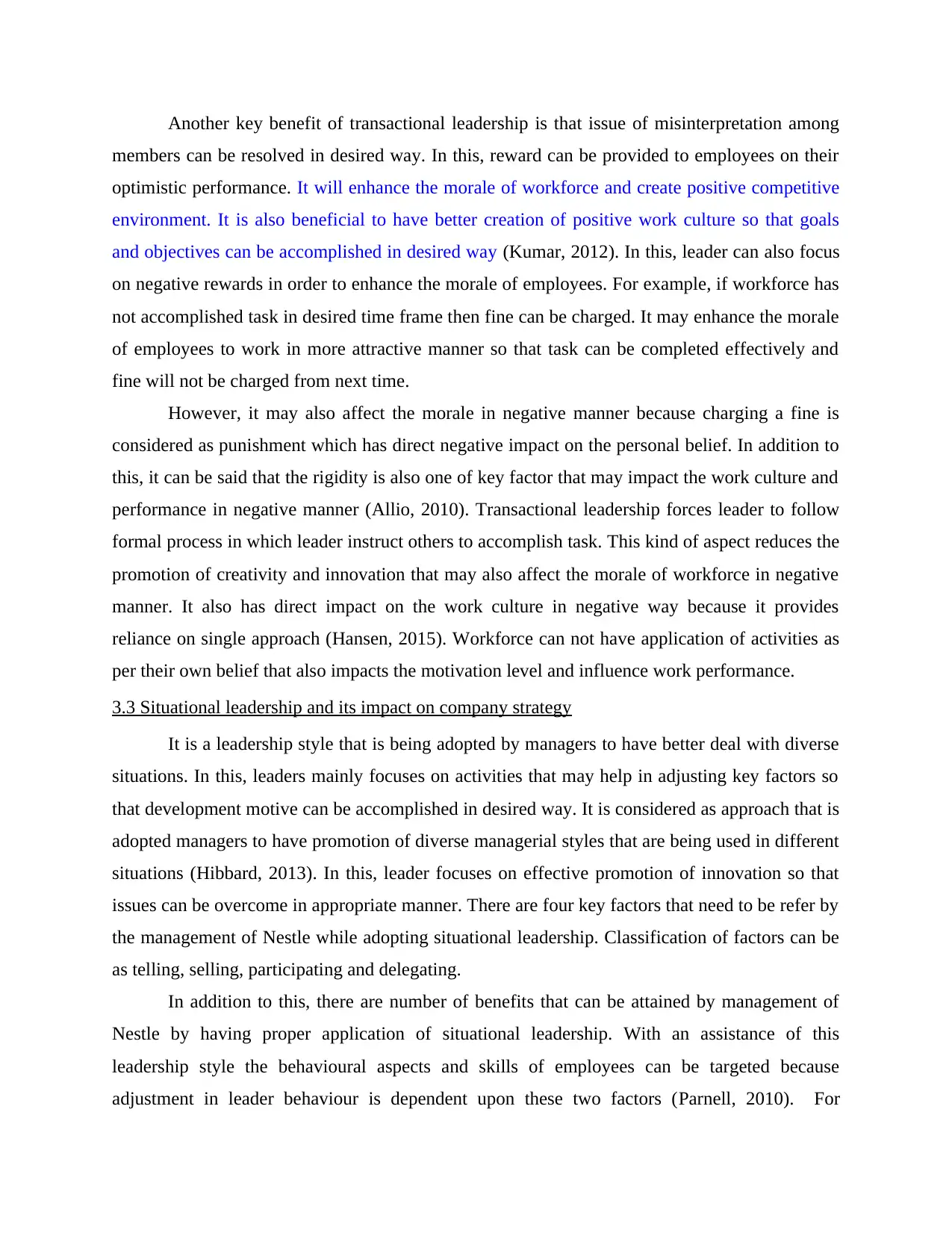
Another key benefit of transactional leadership is that issue of misinterpretation among
members can be resolved in desired way. In this, reward can be provided to employees on their
optimistic performance. It will enhance the morale of workforce and create positive competitive
environment. It is also beneficial to have better creation of positive work culture so that goals
and objectives can be accomplished in desired way (Kumar, 2012). In this, leader can also focus
on negative rewards in order to enhance the morale of employees. For example, if workforce has
not accomplished task in desired time frame then fine can be charged. It may enhance the morale
of employees to work in more attractive manner so that task can be completed effectively and
fine will not be charged from next time.
However, it may also affect the morale in negative manner because charging a fine is
considered as punishment which has direct negative impact on the personal belief. In addition to
this, it can be said that the rigidity is also one of key factor that may impact the work culture and
performance in negative manner (Allio, 2010). Transactional leadership forces leader to follow
formal process in which leader instruct others to accomplish task. This kind of aspect reduces the
promotion of creativity and innovation that may also affect the morale of workforce in negative
manner. It also has direct impact on the work culture in negative way because it provides
reliance on single approach (Hansen, 2015). Workforce can not have application of activities as
per their own belief that also impacts the motivation level and influence work performance.
3.3 Situational leadership and its impact on company strategy
It is a leadership style that is being adopted by managers to have better deal with diverse
situations. In this, leaders mainly focuses on activities that may help in adjusting key factors so
that development motive can be accomplished in desired way. It is considered as approach that is
adopted managers to have promotion of diverse managerial styles that are being used in different
situations (Hibbard, 2013). In this, leader focuses on effective promotion of innovation so that
issues can be overcome in appropriate manner. There are four key factors that need to be refer by
the management of Nestle while adopting situational leadership. Classification of factors can be
as telling, selling, participating and delegating.
In addition to this, there are number of benefits that can be attained by management of
Nestle by having proper application of situational leadership. With an assistance of this
leadership style the behavioural aspects and skills of employees can be targeted because
adjustment in leader behaviour is dependent upon these two factors (Parnell, 2010). For
members can be resolved in desired way. In this, reward can be provided to employees on their
optimistic performance. It will enhance the morale of workforce and create positive competitive
environment. It is also beneficial to have better creation of positive work culture so that goals
and objectives can be accomplished in desired way (Kumar, 2012). In this, leader can also focus
on negative rewards in order to enhance the morale of employees. For example, if workforce has
not accomplished task in desired time frame then fine can be charged. It may enhance the morale
of employees to work in more attractive manner so that task can be completed effectively and
fine will not be charged from next time.
However, it may also affect the morale in negative manner because charging a fine is
considered as punishment which has direct negative impact on the personal belief. In addition to
this, it can be said that the rigidity is also one of key factor that may impact the work culture and
performance in negative manner (Allio, 2010). Transactional leadership forces leader to follow
formal process in which leader instruct others to accomplish task. This kind of aspect reduces the
promotion of creativity and innovation that may also affect the morale of workforce in negative
manner. It also has direct impact on the work culture in negative way because it provides
reliance on single approach (Hansen, 2015). Workforce can not have application of activities as
per their own belief that also impacts the motivation level and influence work performance.
3.3 Situational leadership and its impact on company strategy
It is a leadership style that is being adopted by managers to have better deal with diverse
situations. In this, leaders mainly focuses on activities that may help in adjusting key factors so
that development motive can be accomplished in desired way. It is considered as approach that is
adopted managers to have promotion of diverse managerial styles that are being used in different
situations (Hibbard, 2013). In this, leader focuses on effective promotion of innovation so that
issues can be overcome in appropriate manner. There are four key factors that need to be refer by
the management of Nestle while adopting situational leadership. Classification of factors can be
as telling, selling, participating and delegating.
In addition to this, there are number of benefits that can be attained by management of
Nestle by having proper application of situational leadership. With an assistance of this
leadership style the behavioural aspects and skills of employees can be targeted because
adjustment in leader behaviour is dependent upon these two factors (Parnell, 2010). For
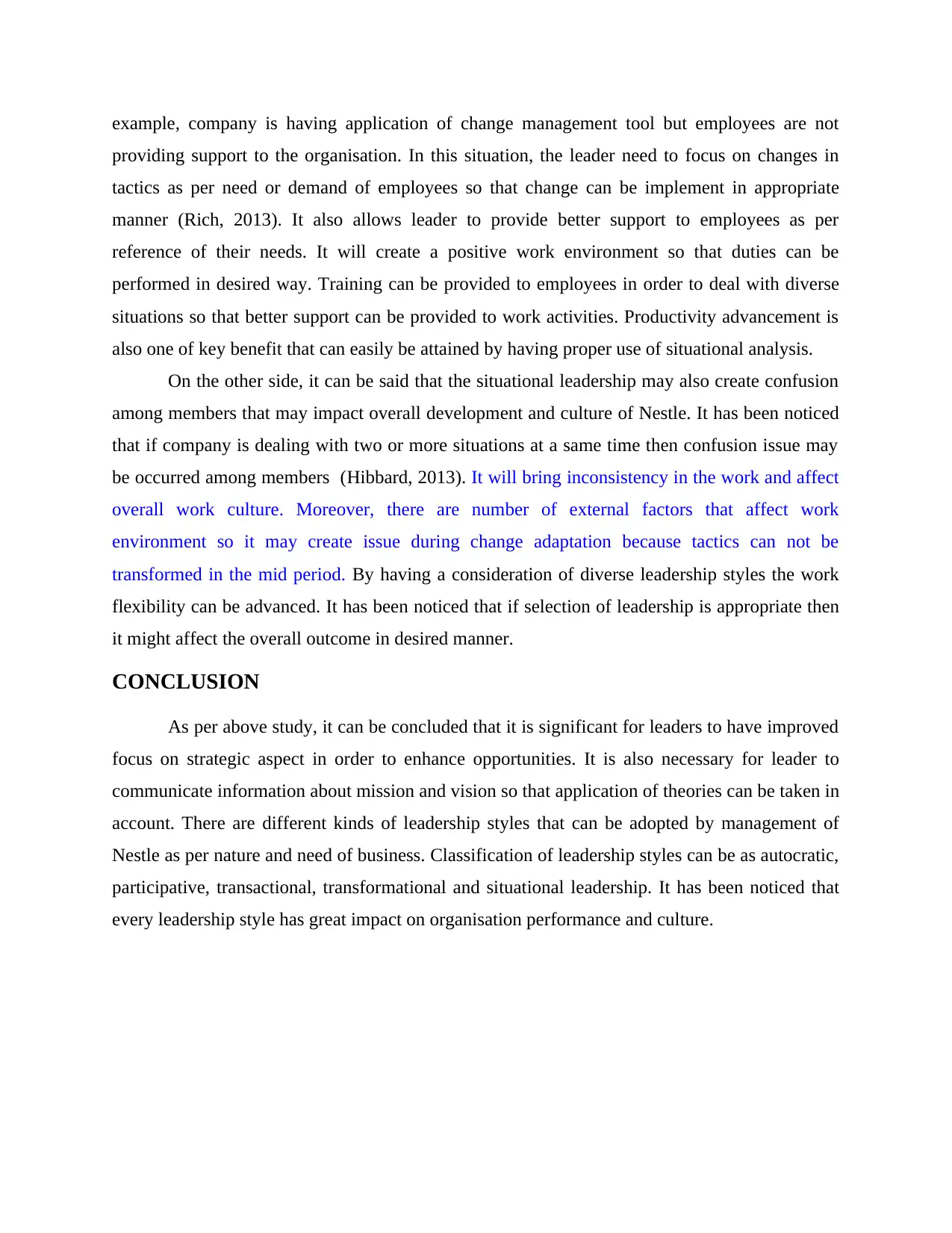
example, company is having application of change management tool but employees are not
providing support to the organisation. In this situation, the leader need to focus on changes in
tactics as per need or demand of employees so that change can be implement in appropriate
manner (Rich, 2013). It also allows leader to provide better support to employees as per
reference of their needs. It will create a positive work environment so that duties can be
performed in desired way. Training can be provided to employees in order to deal with diverse
situations so that better support can be provided to work activities. Productivity advancement is
also one of key benefit that can easily be attained by having proper use of situational analysis.
On the other side, it can be said that the situational leadership may also create confusion
among members that may impact overall development and culture of Nestle. It has been noticed
that if company is dealing with two or more situations at a same time then confusion issue may
be occurred among members (Hibbard, 2013). It will bring inconsistency in the work and affect
overall work culture. Moreover, there are number of external factors that affect work
environment so it may create issue during change adaptation because tactics can not be
transformed in the mid period. By having a consideration of diverse leadership styles the work
flexibility can be advanced. It has been noticed that if selection of leadership is appropriate then
it might affect the overall outcome in desired manner.
CONCLUSION
As per above study, it can be concluded that it is significant for leaders to have improved
focus on strategic aspect in order to enhance opportunities. It is also necessary for leader to
communicate information about mission and vision so that application of theories can be taken in
account. There are different kinds of leadership styles that can be adopted by management of
Nestle as per nature and need of business. Classification of leadership styles can be as autocratic,
participative, transactional, transformational and situational leadership. It has been noticed that
every leadership style has great impact on organisation performance and culture.
providing support to the organisation. In this situation, the leader need to focus on changes in
tactics as per need or demand of employees so that change can be implement in appropriate
manner (Rich, 2013). It also allows leader to provide better support to employees as per
reference of their needs. It will create a positive work environment so that duties can be
performed in desired way. Training can be provided to employees in order to deal with diverse
situations so that better support can be provided to work activities. Productivity advancement is
also one of key benefit that can easily be attained by having proper use of situational analysis.
On the other side, it can be said that the situational leadership may also create confusion
among members that may impact overall development and culture of Nestle. It has been noticed
that if company is dealing with two or more situations at a same time then confusion issue may
be occurred among members (Hibbard, 2013). It will bring inconsistency in the work and affect
overall work culture. Moreover, there are number of external factors that affect work
environment so it may create issue during change adaptation because tactics can not be
transformed in the mid period. By having a consideration of diverse leadership styles the work
flexibility can be advanced. It has been noticed that if selection of leadership is appropriate then
it might affect the overall outcome in desired manner.
CONCLUSION
As per above study, it can be concluded that it is significant for leaders to have improved
focus on strategic aspect in order to enhance opportunities. It is also necessary for leader to
communicate information about mission and vision so that application of theories can be taken in
account. There are different kinds of leadership styles that can be adopted by management of
Nestle as per nature and need of business. Classification of leadership styles can be as autocratic,
participative, transactional, transformational and situational leadership. It has been noticed that
every leadership style has great impact on organisation performance and culture.
⊘ This is a preview!⊘
Do you want full access?
Subscribe today to unlock all pages.

Trusted by 1+ million students worldwide
1 out of 14
Related Documents
Your All-in-One AI-Powered Toolkit for Academic Success.
+13062052269
info@desklib.com
Available 24*7 on WhatsApp / Email
![[object Object]](/_next/static/media/star-bottom.7253800d.svg)
Unlock your academic potential
Copyright © 2020–2025 A2Z Services. All Rights Reserved. Developed and managed by ZUCOL.





